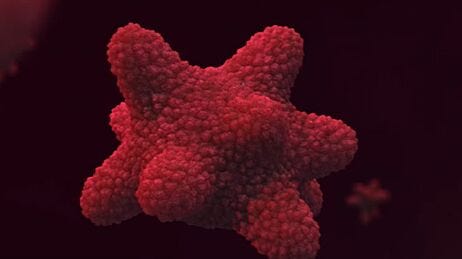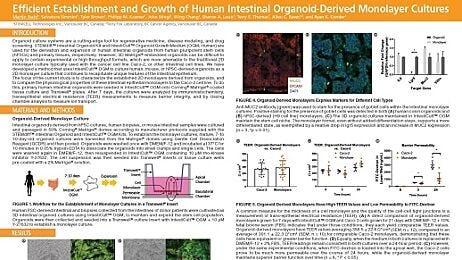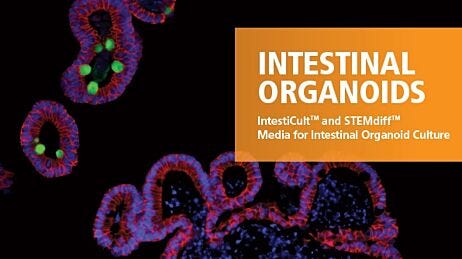Barrier Permeability Assay Using Human Intestinal Organoid-Derived Monolayers
Intestinal organoids provide researchers with a physiologically relevant in vitro cell model and constitute a valuable experimental tool for probing intestinal epithelial cell biology and modeling disease. However, intestinal organoid cultures are limited by their closed luminal compartment—a physical characteristic that presents a challenge for experiments requiring access to the apical surface, such as a barrier permeability assay.
The following protocol provides a step-by-step guide for carrying out barrier permeability assays using human intestinal organoid-derived monolayers, which can facilitate studies to assess novel therapeutic targets, host-pathogen interactions, and more. To learn how to generate human intestinal organoid-derived monolayers prior to performing this assay, see this protocol. Researchers working with specific applications may need to further optimize this protocol.
Materials
- IntestiCult™ Organoid Differentiation Medium (Human) + Organoid Supplement (Catalog #100-0214)
- D-PBS (Catalog #37350)
- Costar® 6.5 mm Transwell® inserts (Catalog #38024) or HTS Transwell®-96 inserts (Catalog #100-0419)
- 4 kDa FITC Dextran (e.g. Sigma-Aldrich Catalog #46944)
- Epithelial Voltohmmeter (e.g. World Precision Instruments, EVOM2™)
- Plate reader
- Pipettor (e.g. Corning® Lambda™ Plus Pipettor, Catalog #38060)
- Pipette tips (e.g. Corning® Filtered Pipette Tips, Catalog #38034)
- Serological pipettes (e.g. Falcon® Serological Pipettes, 10 mL, Catalog #38004)
Protocol
Barrier Permeability Assay
- Start with organoid monolayer cultures that have been maintained for 7 to 10 days (to generate organoid monolayer cultures suitable for this assay, see How to Generate Human Intestinal Organoid-Derived Monolayers Using IntestiCult™).
- Measure trans-epithelial electrical resistance (TEER) using an epithelial voltohmmeter to confirm confluence.
Note: For more information on performing TEER measurements, refer to the instructional videos on How to Perform a TEER Measurement and Correlating TEER Values.
- Prepare IntestiCult™ Organoid Differentiation Medium with no ROCK inhibitor added.
- Thaw an aliquot of 25 mM 4 kDa FITC Dextran.
- Prepare working stocks of each desired drug concentration in IntestiCult™ ODM. Divide each into two aliquots: one for the basolateral wells, and one for the apical wells.
a. For 6.5 mm 24-well Transwell® plates, add 100 µL for each apical well and 600 µL for each basolateral well.
b. For 96-well Transwell® plates, add 50 µL for each apical well and 200 µL for each basolateral well. - Add a 1/100 dilution of FTIC-dextran into the stock for the apical wells.
- Remove medium from each well and wash each apical and basolateral well with PBS.
- Add each media stock to the desired wells.
- Measure TEER at desired intervals (recommended at 0, 3, 24, and 48 hours).
Note: Equilibrate the plate to room temperature for 15 minutes before taking a reading.
- Sample 100 µL media from the basolateral well and load into a black assay plate.
Note: Protect from light.Note: 24-well transwells can be sampled twice during the course of the experiment, 96-well transwells can only be sampled once.
- Measure the presence of FITC-dextran in the basolateral well using a plate reader set to detect 485 nm fluorescence.
Note: Run a FITC-dextran standard curve and control to normalize and evaluate your results.
Explore These Resources
Request Pricing
Thank you for your interest in this product. Please provide us with your contact information and your local representative will contact you with a customized quote. Where appropriate, they can also assist you with a(n):
Estimated delivery time for your area
Product sample or exclusive offer
In-lab demonstration







